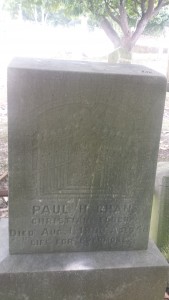Chinese Gravestones
Wong Wa, also known as Wong Yun Wa, was originally from Shack Ma village, which is located in the Poon Yue (today Punya) county of southern China. We know this from the translation into English of his headstone, undertaken by the Chinese Association.
The top two Chinese characters on his headstone denote his village and county of origin. The left hand column reveals his date of death. The central characters represent information about the deceased and the characters in the right hand column show his age. The bottom of the stone records in English his name and year of death.
Unlike many of the restored Chinese headstones, Wong’s is one of the few originals. It has survived much of the vandalism and weathering that has affected many of the others in the area.
Researcher: Kirstie Smitheram
Paul H. Chan migrated to New Zealand from  Canton, China, around 1870. Like many Chinese migrants, he worked on the Central Otago goldfields. In 1889, Chan was committed to Seacliff Mental Hospital near Dunedin under the name Ah Hang. His case file shows that after the trauma of being beaten and robbed by a fellow miner he attempted suicide. Following his release, Chan spent a decade gambling, drinking, and opium smoking before he re-established contact with Presbyterian Missionary Revd. Alexander Don, whom he had met when goldmining. Chan then became actively involved in the Chinese Mission Church in Dunedin. In 1899 he was baptised and named Paul, and later ordained to the eldership.
Canton, China, around 1870. Like many Chinese migrants, he worked on the Central Otago goldfields. In 1889, Chan was committed to Seacliff Mental Hospital near Dunedin under the name Ah Hang. His case file shows that after the trauma of being beaten and robbed by a fellow miner he attempted suicide. Following his release, Chan spent a decade gambling, drinking, and opium smoking before he re-established contact with Presbyterian Missionary Revd. Alexander Don, whom he had met when goldmining. Chan then became actively involved in the Chinese Mission Church in Dunedin. In 1899 he was baptised and named Paul, and later ordained to the eldership.
Chan’s grave is located in a small Chinese section of the Dunedin Southern Cemetery, which lies on a slope below the Presbyterian and Anglican areas. It is the most decorated of the Chinese graves, and represents a fusion of Chinese and Christian traditions. Made of modest concrete, the archway signifies triumph and victory in death, while the gate represents passage to heaven or the afterlife. Above the gate is a hand clasping a cross to symbolise his Christian faith. The Chinese script reads: “Christ, Religion, Chan Paul”. The inscription “Life for Evermore” alludes to his given name ‘Strong Evermore’.


